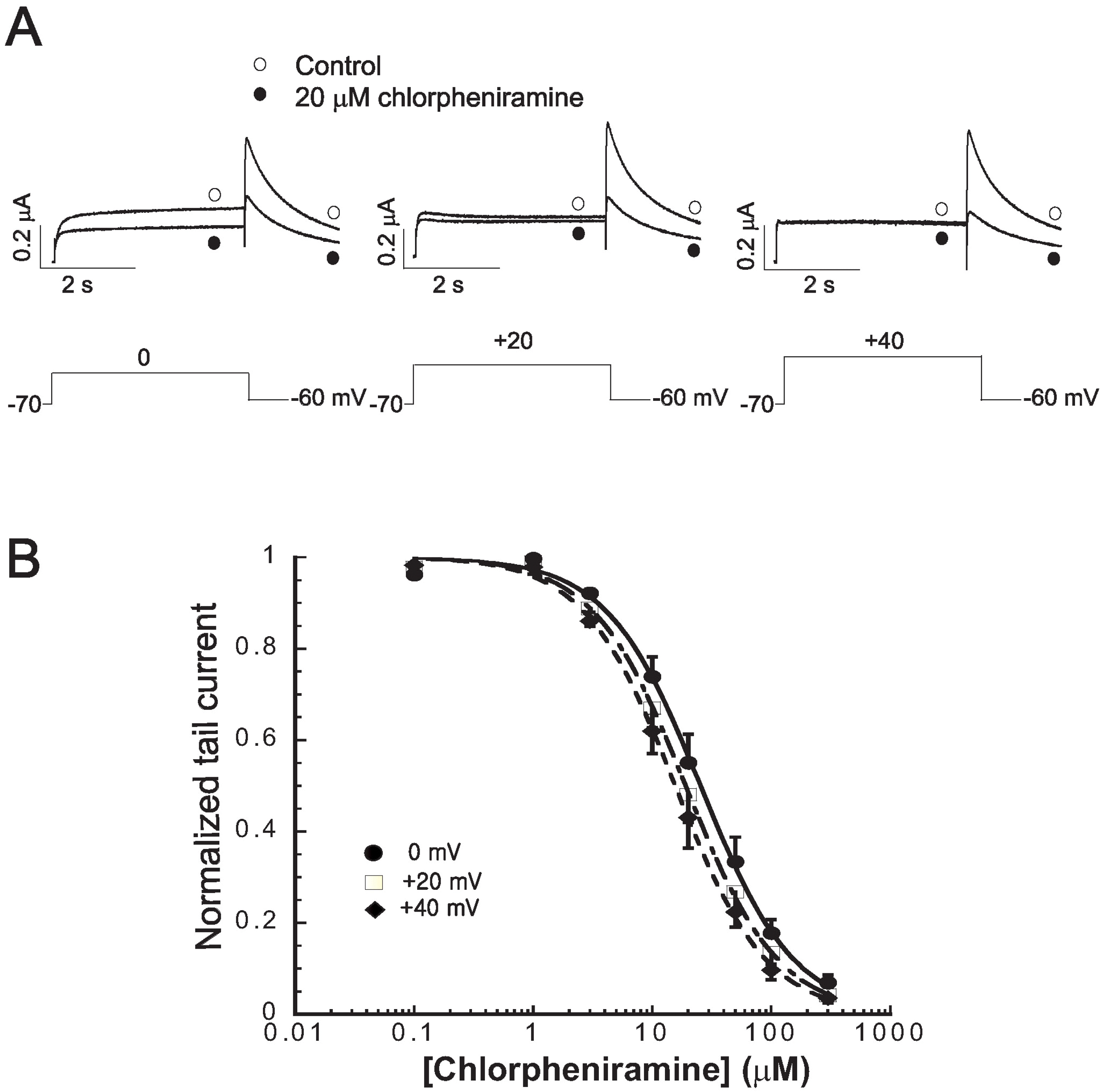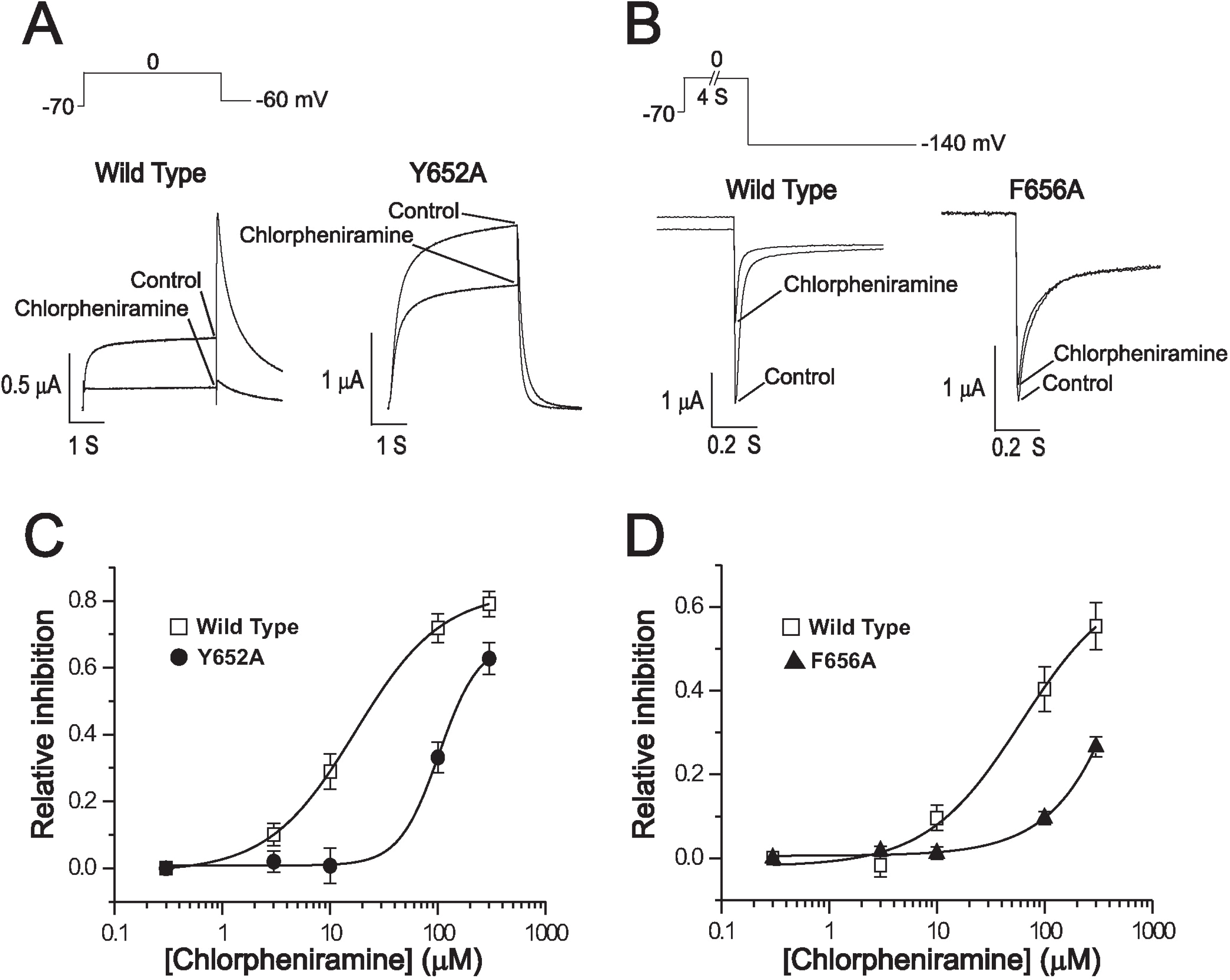Abstract
Chlorpheniramine is a potent first-generation histamine H1 receptor antagonist that can increase action potential duration and induce QT prolongation in several animal models. Since block of cardiac human ether-a-go-go-related gene (hERG) channels is one of leading causes of acquired long QT syndrome, we investigated the acute effects of chlorpheniramine on hERG channels to determine the electrophysiological basis for its proarrhythmic potential. We examined the effects of chlorpheniramine on the hERG channels expressed in Xenopus oocytes using two-microelectrode voltage-clamp techniques. Chlorpheniramine induced a concentration-dependent decrease of the current amplitude at the end of the voltage steps and hERG tail currents. The IC50 of chlorpheniramine-dependent hERG block in Xenopus oocytes decreased progressively relative to the degree of depolarization. Chlorpheniramine affected the channels in the activated and inactivated states but not in the closed states. The S6 domain mutations Y652A and F656A partially attenuated (Y652A) or abolished (F656A) the hERG current block. These results suggest that the H1 antihistamine, chlorpheniramine is a blocker of the hERG channels, providing a molecular mechanism for the drug-induced arrhythmogenic side effects.
Go to : 
REFERENCES
Arcangeli A., Becchetti A., Mannini A., Mugnai G., De Pilippi P., Tarone G., Del Bene MR., Barletta E., Wanke E., Olivotto M. Integrin-mediated neurite outgrowth in neuroblastoma cells depends on the activation of potassium channels. J Cell Biol. 122:1131–1143. 1993.

Arcangeli A., BIanchi L., Becchetti A., Faravelli L., Coronnello M., Mini E., Olivotto M., Wanke E. A novel inward-rectifier K+ current with a cell-cycle dependence governs the resting potential of mammalian neuroblastoma cells. J Physiol (Lond). 489:455–471. 1995.
Baselt R., Cravey R. Disposition of toxic drugs and chemicals in man. 4th ed.Foster City, CA: Chemical Toxicology Institute;1995.
Chiesa N., Rosati B., Arcangeli A., Olivotto M., Wanke E. A novel role for HERG K+ channels: spike-frequency adaptation. J Physiol (Lond). 501:313–318. 1997.
Choi SY., Koh YS., Jo SH. Inhibition of human ether-a-go-go-related gene K+ channel and IKr of guinea pig cardiomyocytes by antipsychotic drug trifluoperazine. J Pharmacol Exp Ther. 313:888–895. 2005.
Goldberg MJ., Spector R., Chiang CK. Transport of diphenhydramine in the central nervous system. J Pharmacol Exp Ther. 240:717–722. 1987.
Huang SM., Chiou WL. Pharmacokinetics and tissue distribution of chlorpheniramine in rabbits after intravenous administration. J Pharmacokinet Biopharm. 9:711–723. 1981.

Hung YM., Chang JC. Weight-reducing regimen associated with polymorphic ventricular tachycardia. Am J Emerg Med. 24:714–716. 2006.

Katzung BG. Histamine, Serotonin, and the ergot alkaloids. Basic and Clinical Pharmacology. 9th ed.McGraw-Hill;San Francisco: p. p. 263–268. 2003.
Ki I., Inui A., Ito T. Effects of histamine H1 receptor antagonists on action potentials in guinea-pig isolated papillary muscles. Arch Int Pharmacodyn Ther. 331:59–73. 1996.
Mitcheson JS. Drug binding to HERG channels: evidence for a “non-aromatic” binding site for fluvoxamine. Br J Pharmacol. 139:883–884. 2003.

Mitcheson JS., Chen J., Lin M., Culberson C., Sanguinetti MC. A structural basis for drug-induced long QT syndrome. Proc Natl Acad Sci USA. 97:12329–12333. 2000.

Redfern WS., Carlsson L., Davis AS., Lynch WG., MacKenzie I., Palethorpe S., Siegl PK., Strang I., Sullivan AT., Wallis R., Camm AJ., Hammond TG. Relationships between preclinical cardiac electrophysiology, clinical QT interval prolongation and torsade de pointes for a broad range of drugs: evidence for a provisional safety margin in drug development. Cardiovasc Res. 58:32–45. 2003.

Sànchez- Chapula JA., Navarro-Polanco RA., Culberson C., Chen J., Sanguinetti MC. Molecular determinants of voltage-dependent human ether-a-go-go related gene (HERG) K+ channel block. J Biol Chem. 277:23587–23595. 2002.
Suessbrich H., Waldegger S., Lang F., Busch AE. Blockade of HERG channels expressed in Xenopus oocytes by the histamine receptor antagonists terfenadine and astemizole. FEBS Lett. 385:77–80. 1996.

Tagawa M., Kano M., Okamura N., Higuchi M., Matsuda M., Mizuki Y., Arai H., Fujii T., Komemushi S., Itoh M., Sasaki H., Watanabe T., Yanai K. Differential cognitive effects of ebastine and (+)-chlorpheniramine in healthy subjects: correlation between cognitive impairment and plasma drug concentration. Br J Clin Pharmacol. 53:296–304. 2002.

Tagawa M., Kano M., Okamura N., Higuchi M., Matsuda M., Mizuki Y., Arai H., Iwata R., Fujii T., Komemushi S., Ido T., Itoh M., Sasaki H., Watanabe T., Yanai K. Neuroimaging of histamine H1-receptor occupancy in human brain by positron emission tomography (PET): a comparative study of ebastine, a second-generation antihistamine, and (+)-chlorpheniramine, a classical antihistamine. Br J Clin Pharmacol. 52:501–509. 2001.

Taglialatela M., Castaldo P., Pannaccione A., Giorgio G., Genovese A., Marone G., Annunziato L. Cardiac ion channels and antihistamines: possible mechanisms of cardiotoxicity. Clin Exp Allergy. 29:182–189. 1999.

Taglialatela M., Timmerman H., Annunziato L. Cardiotoxic potential and CNS effects of first-generation antihistamines. Trends Pharmacol Sci. 21:52–56. 2000.

Tie H., Walker BD., Valenzuela SM., Breit SN., Campbell TJ. The heart of psychotropic drug therapy. Lancet. 355:1825. 2000.

Venkatraman N., O'Neil D., Hall AP. Life-threatening overdose with lamotrigine, citalopram, and chlorpheniramine. J Postgrad Med. 54:316–317. 2008.

Wymore RS., Gintant GA., Wymore RT., Dixon JE., Mckinnon D., Cohen IS. Tissue and species distribution of mRNA for the IKr-like K+ channel, erg. Circ Res. 80:261–268. 1996.
Go to : 
 | Fig. 1.The effect of chlorpheniramine on human-ether-a-go-go-related gene (hERG) currents (IHERG) elicited by depolarizing voltage pulses. (A) Superimposed current traces elicited by depolarizing voltage pulses (4 s) to +30 mV steps (upper panel) from a holding potential of – 70 mV in the absence of chlorpheniramine (control) and in the presence of 1~300 μM chlorpheniramine (lower panel). (B) Plot of the normalized tail current measured at its peak just after repolarization (n=6). The peak amplitude of the tail current in the absence of the drug was set as 1. Control data were fitted to the Boltzmann Equation, y=1/{1+exp[(–V+V1/2)/dx]}, with V1/2 of −25.7 mV. (C) Activation curves with values normalized to the respective maximum value at each concentration of chlorpheniramine. Symbols with error bars represent mean±S.E.M. (n=3~5). |
 | Fig. 2.Voltage dependence of chlorpheniramine-induced hERG current block. (A) Current traces from a cell depolarized to 0 mV (left panel), +20 mV (middle panel) and +40 mV (right panel), before and after exposure to 20 μM chlorpheniramine, showing increased block of hERG current at more positive membrane potentials. The protocol consisted of 4 s depolarizing steps to 0 mV, +20 mV or +40 mV from a holding potential of −70 mV, followed by repolarization to −60 mV. (B) Concentration-dependent block of IHERG by chlorpheniramine at different membrane potentials. At each depolarizing voltage step (0 mV, +20 mV or +40 mV), the tail currents in the presence of various concentrations of chlorpheniramine were normalized to the tail current obtained in the absence of drug, and then plotted against chlorpheniramine concentrations. Symbols with error bars represent mean±S.E.M (n=6). The line represents the data fits to the Hill equation. |
 | Fig. 3.Blocking of activated hERG channels by chlorpheniramine. (A) An original recording of currents under control conditions (control) and after exposure to 50 μM chlorpheniramine (for 13 min, without any intermittent test pulse). (B) The degree of hERG-current inhibition in percentages (%). Current inhibition increased time-dependently to 76% at 1 s in this representative cell, indicating that mostly open and/or inactivated channels were blocked. (C) Inhibition of inactivated channels by 20 μM chlorpheniramine. hERG channels were inactivated by a first voltage-step to +80 mV, followed by channel opening at 0 mV. (D) The corresponding relative block during the 0 mV step is displayed. Maximum inhibition was achieved in the inactivated state during the first step, and no further time-dependent block occurred upon channel opening during the second voltage step. |
 | Fig. 4.Concentration-dependent inhibition of WT and mutant hERG channels expressed in oocytes. (A, B) Representative traces for WT and mutant HERG channel currents in the presence and absence of indicated concentrations of chlorpheniramine. The effect of the drug on WT and Y652A was quantified during a 4 s activating pulse to 0 mV from a holding potential of −90 mV. To increase the amplitude of poorly expressed F656A mutant channels, tail currents were recorded at −140 mV instead of −60 mV after the 4 s activating pulses. (C, D) The concentration-response curves were fitted with a logistic dose-response equation to obtain the IC50 values of 17.1±0.1 μM (n=5), 102.7±27.7 μM (n=7), 61.1± 37.8 μM (n=7), and 2,153.2±3.1 μM (n=7) in WT (obtained using protocol of panel A), Y652A, WT (obtained using protocol of panel B), and F656A HERG channels, respectively. The potency of chlorpheniramine block was reduced in the mutant channels. Data were expressed as mean±S.E.M. |




 PDF
PDF ePub
ePub Citation
Citation Print
Print


 XML Download
XML Download